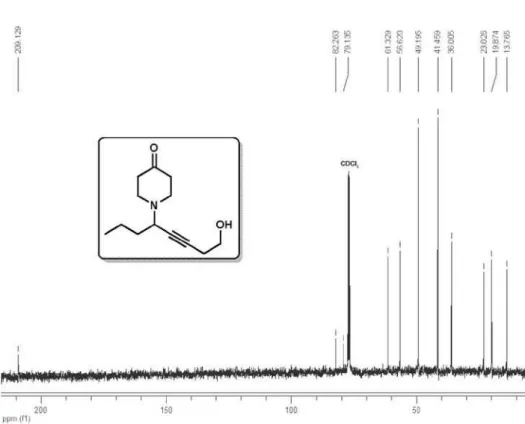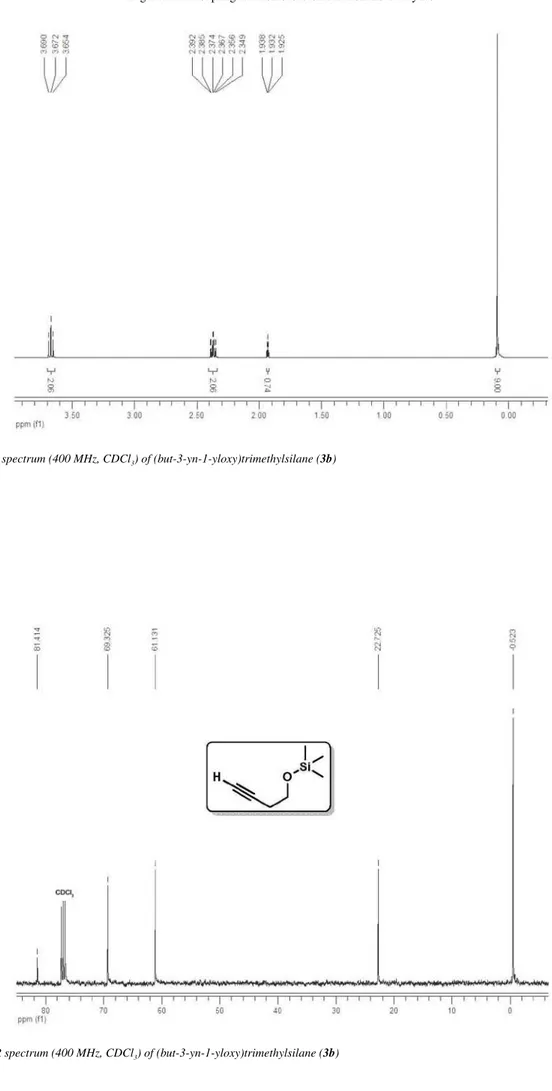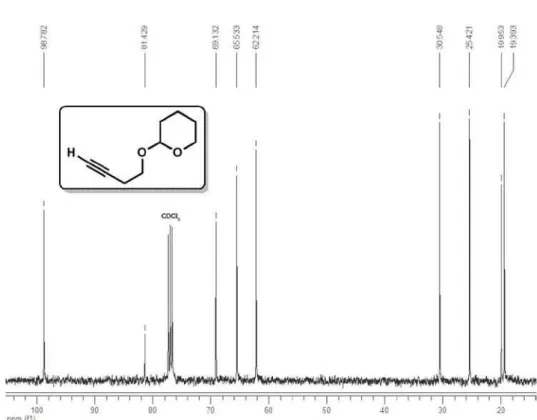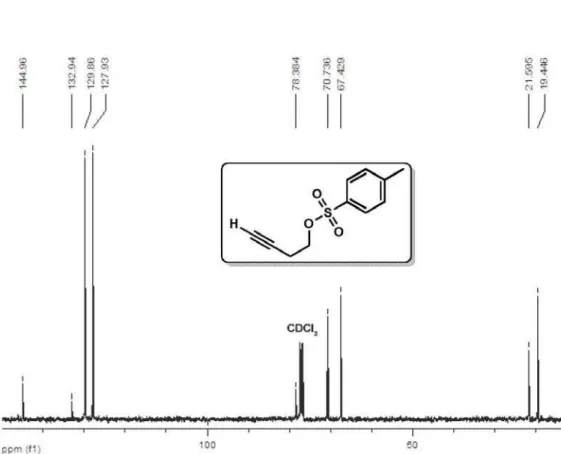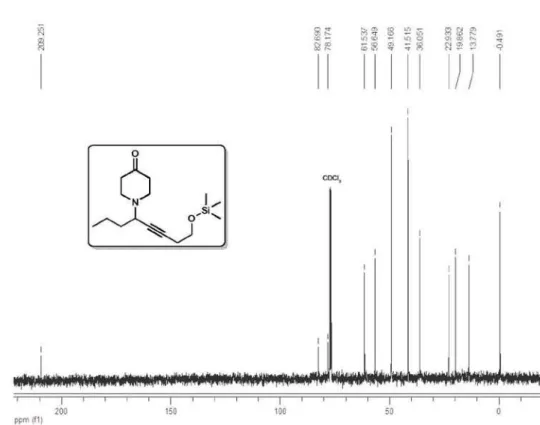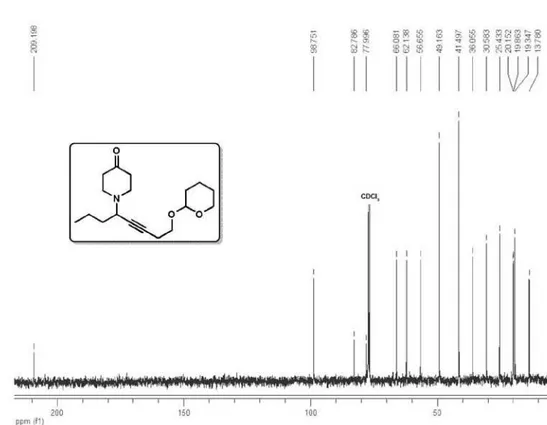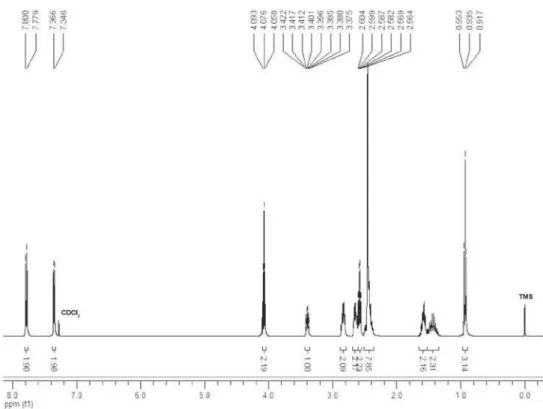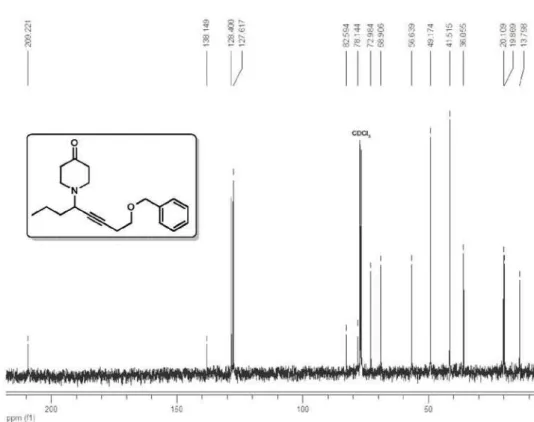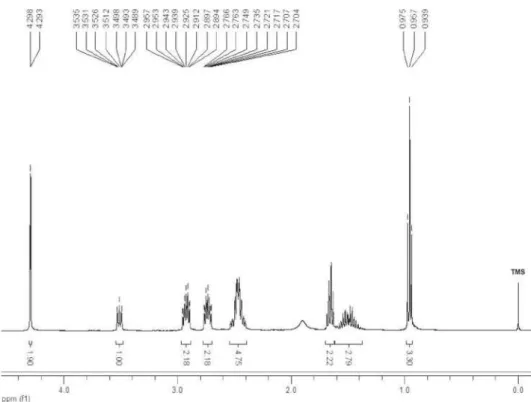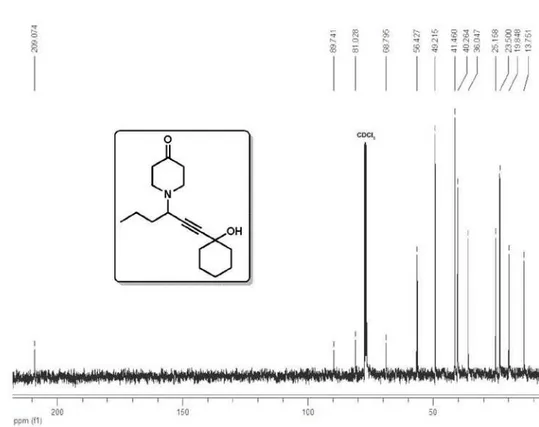Artigo
*e-mail: alcindo@iq.usp.br
A GENERAL A3-COUPLING REACTION BASED ON FUNCTIONALIZED ALKYNES
Edison P. Wendler and Alcindo A. Dos Santos*
Instituto de Química, Universidade de São Paulo, Av. Prof. Lineu Prestes, 748, CP 26077, 05599-970 São Paulo – SP, Brasil Recebido em 15/1/13; aceito em 16/4/13; publicado na web em 17/7/13
A range of hydroxypropargylpiperidones were efficiently obtained by a one-pot three-component coupling reaction of aldehydes, alkynols, and a primary amine equivalent (4-piperidone hydrochloride hydrate) in ethyl acetate using copper(I) chloride as a catalyst. The developed protocol proved to be equally efficient using a range of aliphatic aldehydes, including paraformaldehyde, and using protected and unprotected alkynols.
Keywords: hydroxypropargylamine; multicomponent reaction; A3-coupling.
INTRODUCTION
Connecting organic fragments that have desired functionalities by short and inexpensive synthetic routes is one of the most exciting and challenging tasks for organic chemists, and it requires a high level of creativity and elegance.
Recently, multicomponent reactions have been receiving significant attention, because multiple carbon–carbon and carbon– heteroatom bonds can be generated in a single step, allowing for the straightforward construction of intricate organic compounds. Recent developments in this area have been very impressive, and procedures involving seven1 and even eight2 components have been reported.
The three-component coupling of aldehydes, amines, and alkynes (A3-coupling) is a very efficient method for forming propargylami-nes by C–H activation.3 A3-coupling is more practical than the other methods available for preparing this class of compounds, because no moisture-sensitive stoichiometric organometallics, such as Grignard or organolithium reagents, are involved. It is also applicable to various substrates. This transformation can be catalyzed by a large number of transition-metal salts, including copper,4 iron,5 cobalt,6 nickel,7 zinc,8 ruthenium,9 silver,10 cadmium,11 indium,12 ytterbium,13 iridium,14 gold,15 mercury,16 bimetallic salt combinations,17 supported metals,18 andnanostructured materials.19 It is interesting to note that, although the use of various amines and aldehydes in this method has been described, the number of alkynes used has been limited. Non-functionalized alkynes, such as phenylacetylene and trimethyl-silylacetylene, have been used most frequently, but the A3-coupling of alkynols, to prepare functionalized allenols, has recently been described.20
In 2006, Gommermann and Knochel described the use of an A3-coupling silylated adduct in the asymmetric synthesis of (S)-(+)-coniine.21 We know of only a few examples of unprotected alkynols being used in the A3-coupling reaction, and all of them, except for ones we have previously reported,22 have been limited to aromatic aldehydes.23,24 A general procedure for the preparation of hydroxy-propargylamines would be very desirable because these chemicals are direct precursors for alkaloids. The desired carbon skeleton could be achieved in a one-pot process using an A3-coupling-type protocol and using the correct functionalities for cyclization to form five- and six- (and higher) ring alkaloid systems.
In 2006, Carreira reported using 4-piperidone hydrochloride
hydrate as a secondary amine source in an A3-coupling reaction.25 The authors demonstrated that using this amine source allowed the A3-coupling adducts (tertiary amines) to be easily converted into the corresponding primary amines, in good yields, by their reac-tion with an amino-polystyrene resin scavenger or with a saturated ammonia–ethanolic solution. This procedure is highly compatible with chemicals containing a triple bond, and in the presence of a hydroxyl group, it permits the isolation of the corresponding hydro-xypropargylamine, which can be converted into the corresponding hydroxyallylamine or the fully saturated amino alcohol, which are valuable building blocks.
Here we present a general protocol, which is complementary to the methodologies described above, for preparing hydroxypropargyla-mines using catalytic amounts of CuCl to promote A3-coupling by C–H activation among aliphatic aldehydes, 4-piperidone, protected and unprotected alkynols, and non-functionalized alkynes.
RESULTS AND DISCUSSION
To test the feasibility of using alkynols in the A3-coupling reac-tion, we screened a range of solvents, temperatures, and potential metal catalysts in the reaction of butyraldehyde (1a), 4-piperidone hydrochloride hydrate (2), and homopropargyl alcohol (3a) using 4 Å molecular sieves as a dehydrating agent (Table 1).
as reported for entry 12 (3 mmol scale) to assess the influence of other functional groups on the alkyne. These substrates tolerated the reaction conditions well, allowing the corresponding adducts 4b–e to be isolated in good yields, free of exogenous byproducts (Scheme 1).
Table 1. Solvent, catalyst and temperature screening for A3-coupling reaction
Entry Solvent Catalyst (mol%) Temp. (°C) (%)Yield a,b,c
Time (h)d
1 Hexane CuCl (5) r.t. 74 15
2 1,4-Dioxane “ “ 82 15
3 Toluene “ “ 87 19
4 Et2O “ “ 75 20
5 THF “ “ 62 20
6 CH2Cl2 “ “ 33 24
7 MeOH “ “ 14 36
8 CH3CN “ “ 10 24
9 H2Oe “ “ 22 48
10 EtOAc “ “ 81 18
11 “ “ 50 76 12
12 “ “ 70 71/75f/80g 4
13 “ “ (0.1) “ 2 “
14 “ “ (0.5) “ 13 “
15 “ “ (1.0) “ 32 “
16 “ “ (2.5) “ 50 “
17 “ “ (7.5) “ 71 “
18 “ “ (10) “ 72 “
19 “ “ (25) “ 76 “
20 “ “ (50) “ 80 “
21 “ CuBr (5) “ 71 “
22 “ CuI (5) “ 59 “
23 “ CuCN (5) “ 32 “
24 “ AgI (5) “ --- “
25 “ HgCl2 (5) “ Trace “
26 “ Zn(OAc)2 (5) “ Trace “
a All reactions were conducted under an air atmosphere, and the solvents were used without special treatment. b Isolated yields. c In some cases, small amounts of alkyne homocoupling byproducts were detected, but they were easily removed by performing an acid–base liquid extraction. d All reactions were monitored by GC-FID. e 4 Å molecular sieves were not used. f Reac-tion was performed at the 50 mmol scale. g Reaction was performed at the 100 mmol scale.
Scheme 1. A3-coupling using different homopropargyl derivatives
Based on these results, we applied the conditions to the reactions of other alkynols (3f–o) with 1a, and the results are summarized in Table 2.
From Table 2, it can be seen that the A3-coupling reactions using alkynols and aliphatic aldehydes gave better results than the reactions using non-functionalized alkynes (compare entries 1–7 with 8–10). Other aldehydes (1b–h) were reacted with 4-pentyn-2-ol (3f) (Table 3) to assess the scope and limitations of the protocol.
It is worth noting that adduct 4p was isolated in reasonable yield (59%) from the reaction using the equivalent of formaldehyde (paraformaldehyde, 1b) (Table 3, entry 1). Even volatile aldehydes, such as n-propanaldehyde (1c) and isobutyraldehyde (1d), were successfully converted into the corresponding A3-coupling adducts in good yields (entries 2 and 3, respectively). The yields were equally good when medium-chain 1f and long-chain 1g aldehydes were used (entries 5 and 6, respectively). Aromatic aldehydes did not give the corresponding adducts in acceptable yields, but the benzylic aldehyde 1h gave the desired adduct 4v in good yield (entry 7).
In general, aliphatic and cyclic primary, secondary, and tertiary alkynols gave the desired A3-coupling adducts in good yields without the detection of any dehydration products or other byproducts (see Tables 1-3).
As described by Carreira et al.,25 4-piperidones can be converted into the corresponding primary propargylamines by refluxing in an NH4Cl/ammonia-saturated ethanolic solution or by heating in the pre-sence of an amine-polystyrene resin in an NH4Cl/ethanolic solution. Using this approach, hydroxypropargyl-4-piperidones produced in our study were eventually converted into the corresponding amino alcohols.
To the best of our knowledge, there has been only one report of the synthesis of a piperidine alkaloid, (S)-(+)-coniine, from an A3-coupling adduct.21 The three-component reaction strategy using trimethylsilylacetylene as the alkyne component was used to produce that chemical; hence, a -CH2CH2OH unit had to be introduced by the methylene oxide alkylation reaction after deprotonation using n-BuLi. The strategy we have demonstrated here, i.e., using alkynols as the alkyne component, is complementary to the approach employed by Gommermann and Knochel, because no additional chain homolo-gation is required to prepare the amino-alcohol skeleton needed for preparing cyclic alkaloids.
CONCLUSIONS
We have demonstrated, for the first time, a general and selective CuCl-catalyzed A3-coupling reaction for preparing hydroxypropar-gyl-4-piperidones, which are valuable precursors for cyclic alkaloids. The procedure gives good yields and has short reaction times, and hydroxypropargylamines can be prepared using functionalized alkyne sources (free alcohols, silyl ethers, ethers, ketals, and tosylates). Even volatile aliphatic aldehydes were well tolerated in the procedure, and the corresponding adducts were isolated in good yields.
EXPERIMENTAL
All reagents were purchased from Aldrich. Thin layer chromato-graphy (TLC) was performed using silica gel 60 F254 precoated plates,
Table 2. A3-coupling reaction of butyraldehyde and different alkynols
Entry R Adduct / number Yield (%)a Time (h)b
1 4f 72 4.5
2 4g 75 4
3 4h 73 6
4 4i 76 5.5
5 4j 85 5.5
6 4k 80 6.5
7 4l 77 4
8 4m 69 4
9 4n 66 4
10 4o 62 6
a Isolated yields. bAll reactions were monitored by GC-FID.
Table 3. A3-coupling reaction using different aliphatic aldehydes
Entry R1 Adduct / number Yield (%)a Time (h)b
1c H 4p 59d 24
2 4q 65d 4.5
3 4r 99e 5
4 4s 97f 5
5 4t 78f 4.5
6 4u 75f 6
7 4v 72f 5
Scheme 2. Proposed catalytic cycle in the A3-coupling reaction
and the chemicals were made visible using vanillin as a coloring rea-gent (using 1.0 g vanillin in a 99:1 CH3CO2H / H2SO4 solution). Gas chromatography (GC) was performed using a Shimadzu® GC2014 instrument equipped with a DB-5 column (30 m length, 0.25 mm id, 0.25 µm film) and a flame ionization detector (FID). All new compounds were characterized by NMR, IR, EI-MS, and ESI-HRMS spectroscopy. The 1H NMR (400 MHz) and 13C NMR (100 MHz) spectra were recorded on a Bruker® DRX 400 spectrometer using tetramethylsilane (TMS) as the internal standard. Chemical shifts are reported in parts per million (ppm, δ) downfield of TMS. The IR spectra were recorded using a Bomen Hartmann & Braun® MB-Series Model Arid-Zone® instrument. Low-resolution mass spectra were recorded using a Shimadzu® QP 5000 mass spectrometer after gas chromatographic separation using an HP-5MS GC column (30 m length, 0.25 mm id, 0.25 µm film). High-resolution mass spectra were recorded using a Bruker® Daltonics MicroTOF Ic LC/MS instrument from direct injections of the pure samples.
General procedure for the synthesis of hydroxypropargylamine derivatives
CuCl (0.009 g, 0.1 mmol), 4 Å molecular sieves (0.300 g), 4-pipe-ridone hydrochloride monohydrate (0.169 g, 1.1 mmol), and EtOAc (2 mL) were added, in that order, to a 10-mL round-bottomed flask. The mixture was stirred at 70 °C and then triethylamine (0.110 g, 0.15 mL, 1.1 mmol), alkynol (2.0 mmol), and the appropriate freshly distilled aldehyde (1.0 mmol) were added. The reaction mixture was stirred, and the progress of the reaction was monitored by GC-FID or TLC. The reaction mixture was passed through a short pad of Celite® in a column and eluted with EtOAc (3 × 5 mL). A saturated NH4Cl solution (10 mL) was added to the organic phase, and the mixture was stirred vigorously for 20 min, separated, and the organic phase was treated with HCl (15 mL, 10% v/v) in a separatory funnel. The aqueous phase was washed with EtOAc (10 mL) to remove any homo-coupling products, neutralized with a saturated NaHCO3 solution (3 × 10 mL) and extracted again with EtOAc (4 × 10 mL). The organic phases were combined, dried over MgSO4, filtered, and concentrated under reduced pressure. The residue was purified by silica-gel column
chromatography using the appropriate eluent. SUPPLEMENTARY MATERIAL
The 1H NMR, 13C NMR, IR, EI-MS, and EI-HRMS spectra, and the corresponding spectral data, for all of the newly synthesized compounds are available as supplementary material.
ACKNOWLEDGMENTS
The authors thank the São Paulo Research Foundation (FAPESP no. 2011/11613-8, 2011/17228-6 and 05/59572-7), Coordination for the Improvement of Higher Education Personnel (CAPES no. 23038.000497/2010-14), and the Brazilian National Council for Scientific and Technological Development (CNPq no. 57.5417/2008-0) for financial support. The authors are also grateful for the financial and structural support offered by the University of São Paulo throu-gh the NAP-CatSinQ (Research Core in Catalysis and Chemical Synthesis). The authors also thank Prof. Dr. P. H. C. Camargo for revising this manuscript. E. P. Wendler is grateful to CAPES for scholarship funding and the Federal University of São Carlos for providing access to their facilities.
REFERENCES
1. Dömling, A.; Ugi, I.; Angew. Chem. Int. Ed. 1993, 32, 563; Dömling, A.; Herdtweck, E.; Ugi, I.; Acta Chem. Scand. 1998, 52, 107; Brauch, S.; Gabriel, L.; Westermann, B.; Chem. Commun. 2010, 46, 3387. 2. Elders, N.; Van der Born, D.; Hendrickx, L. J. D.; Timmer, B. J. J.;
Krause, A.; Janssen, E.; de Kanter, F. J. J.; Ruijter, E.; Orru, R. V. A.; Angew. Chem. Int. Ed. 2009, 48, 5856.
3. (Authors available only in japanese); Jpn. Kokai Koho Patent JP 58069845 A, 1983; Youngman, M. A.; Dax, S. L.; Tetrahedron Lett.
1997, 38, 6347.
Chem. 2010, 4861; Bariwal, J. B.; Ermolat’ev, D. S.; Glasnov, T. N.; Van Hecke, K.; Mehta, V. P.; Van Meervelt, L.; Kappe, C. O.; Van der Eycken, E. V.; Org. Lett. 2010, 12, 2774; Li, P.; Pereshivko, O. P.; Peshkov, V. A.; Van der Eycken, E. V.; Org. Lett. 2010, 12, 2638; Nandakumar, A.; Muralidharan, D.; Perumal, P. T.; Tetrahedron Lett.
2011, 52, 1644; Luz, I.; Llabrés i Xamena, F. X.; Corma, A.; J. Catal.
2012, 285, 285.
5. Chen, W-W.; Nguyen, R. V.; Li, C-J.; Tetrahedron Lett. 2009, 50, 2895; Patil, S. S.; Patil, S. V.; Bobade, V. D.; Synlett 2011, 2379.
6. Chen, W-W.; Bi, H-P.; Li, C-J.; Synlett 2010, 475.
7. Namitharan, K.; Pitchumani, K.; Eur. J. Org. Chem. 2010, 411; Samai, S.; Nandi, G. C.; Singh, M. S.; Tetrahedron Lett. 2010, 51, 5555. 8. Kantan, M. L.; Balasubrahmanyam, V.; Shiva Kumar, K. B.; Venkanna,
G. T.; Tetrahedron Lett. 2007, 48, 7332.
9. Sinha, P.; Raghuvanshi, D. S.; Singh, K. N.; Mishra, L.; Polyhedron
2012, 31, 227.
10. Reddy, K. M.; Babu, N. S.; Suryanarayana, I.; Prasad, P. S. S.; Lingaiah, N.; Tetrahedron Lett. 2006, 47, 7563; Huang, B.; Yao, X.; Li, C-J.; Adv. Synth. Catal. 2006, 348, 1528; He, T.; Zha, Z.; Pan, C.; Wang, Z.; Synth. Comm. 2007, 37, 849; Li, Z.; Wei, C.; Chen, L.; Varma, R. S.; Li, C-J.; Tetrahedron Lett. 2004, 45, 2443.
11. Raghuvanshi, D. S.; Singh, K. N.; Synlett 2011, 373.
12. Zhang, Y.; Li, P.; Wang, M.; Wang, L.; J. Org. Chem. 2009, 74, 4364. 13. Kumar, A.; Rao, V. K.; Synlett 2011, 2157.
14. Fischer, C.; Carreira, E. M.; Org. Lett. 2001, 3, 4319; Sakagushi, S.; Kubo, T.; Ishii, Y.; Angew. Chem. Int. Ed. 2001, 40, 2534.
15. Lo, V.; K-Y.; Liu, Y.; Wong, M-K.; Che, C-M.; Org. Lett. 2006, 8, 1529; Wei, C.; Li, C-J.; J. Am. Chem. Soc. 2003, 125, 9584; Abahmane, L.; Köhler, J. M.; Groβ, G. A.; Chem. Eur. J. 2011, 17, 3005; Kung, K. K-Y.; Li, G-L.; Zou, L.; Chong, H-C.; Leung, Y-C.; Wong, K-H.; Lo, V. K-Y.; Che, C-M.; Wong, M-K.; Org. Biomol. Chem. 2012, 10, 925. 16. Li, P-H.; Wang, L.; Chin. J. Chem. 2005, 23,1076.
17. Chernyak, N.; Gevorgyan, V.; Angew. Chem. Int. Ed. 2010, 49, 2743; Chernyak, D.; Chernyak, N.; Gevorgyan, V.; Adv. Synth. Catal. 2010, 352, 961; Aliaga, M. J.; Ramón, D. J.; Yus, M.; Org. Biomol. Chem.
2010, 8, 43; Zhang, K.; Huang, Y.; Chen, R.; Tetrahedron Lett. 2010, 51, 5463; Li, C-J.; Wei, C.; Chem. Commun. 2002, 268.
18. Wang, M.; Li, P.; Wang, L.; Eur. J. Org. Chem. 2008, 2255; Fodor, A.; Kiss, A.; Debreczeni, N.; Hell, Z.; Gresits, I.; Org. Biomol. Chem.
2010, 8, 4575; Li, P.; Wang, L.; Zhang, Y.; Wang, M.; Tetrahedron Lett.
2008, 49, 6650; Sreedhar, B.; Reddy, P. S.; Krishna, C. S. V.; Babu, P. V.; Tetrahedron Lett. 2007, 48, 7882; Patil, M. K.; Keller, M.; Reddy, B. M.; Pale, P.; Sommer, J.; Eur. J. Org. Chem. 2008, 4440; Choudary, B. M.; Sridhar, C.; Kantam, M. L.; Sreedhar, B.; Tetrahedron Lett. 2004, 45, 7319; Yong, G-P.; Tian, D.; Tong, H-W.; Liu, S-M.; J. Mol. Catal. A-Chem. 2010, 323, 40; Li, Y.; Chen, X.; Song, Y.; Fang, L.; Zou, G.; Dalton Trans. 2011, 40, 2046; Maggi, R.; Bello, A.; Oro, C.; Sartori, G.; Soldi, L.; Tetrahedron 2008, 64, 1435.
19. Kidwai, M.; Banasal, V.; Kumar, A.; Mozumdar, S.; Green Chem. 2007, 9, 742; Li, P.; Wang. L.; Tetrahedron 2007, 63, 5455; Kantam, M. L.; Yadav, J.; Laha, S.; Jha, S.; Synlett 2009, 1791; Bhatte, K. D.; Sawant, D. N.; Deshmukh, K. M.; Bhanage, B. M.; Catal. Commun. 2011, 16, 114; Kidwai, M.; Bansal, V.; Mishra, N. K.; Kumar, A.; Mozumdar, S.; Synlett 2007, 1581; Layek, K.; Chakravarti, R.; Kantam, M. L.; Maheswaran, H.; Vinu, A.; Green Chem. 2011, 13, 2878; Sreedhar, B.; Kumar, A. S.; Reddy, P. S.; Tetrahedron Lett. 2010, 51, 1891. 20. Kuang, J.; Luo, H.; Ma, S.; Adv. Synth. Catal. 2012, 354, 933; Ye, J.;
Li, S.; Chen, B.; Fan, W.; Kuang, J.; Liu, J.; Liu, Y.; Miao, B.; Wan, B.; Wang, B.; Xie, X.; Yu, Q.; Yuan, W.; Ma, S.; Org. Lett. 2012, 14, 1346. 21. Gommermann, N.; Knochel, P.; Chem. Eur. J. 2006, 12, 4380. 22. Melgar, G. Z.; Wendler, E. P.; Dos Santos, A. A.; Porto, A. L. M.;
Tetrahedron Asymm. 2010, 21, 2271.
23. Wei, C.; Mague, J. T.; Li, C-J.; Proc. Natl. Acad. Sci. USA 2004, 101, 5749; Yadav, J. S.; Reddy, B. V. S.; Naveenkumar, V.; Rao, R. S.; Nagaiah, K.; New J. Chem. 2004, 28, 335; Shi, L.; Tu, Y-Q.; Wang, M.; Zhang, F-M.; Fan, C-A.; Org. Lett. 2004, 6, 1001.
24. Ramu, E.; Varala, R.; Sreelatha, N.; Adapa, S. R.; Tetrahedron Lett.
2007, 48, 7184.
25. Aschwanden, P.; Stephenson, R. J.; Carreira, E. M.; Org. Lett. 2006, 8, 2437; Carreira, E. M.; WIPO Patent WO 2005121157 A1, 2005. 26. Bisai, A.; Singh, V. K.; Org. Lett. 2006, 8, 2405.
27. Zeng, T.; Chen, W-W.; Cirtiu, C. M.; Moores, A.; Song, G.; Li, C-J.; Green Chem. 2010, 12, 570.
28. Prices from Sigma-Aldrich Catalog 2009-2010: CuCl (97%) = 0.06 US$/g; CuBr (98%) = 0.25 US$/g.
29. Bariwal, J. B.; Ermolat’ev, D. S.; Van der Eycken, E. V.; Chem. Eur. J.
2010, 16, 3281; Feng, H.; Ermolat’ev, D. S.; Song, G.; Van der Eycken, E. V.; Org. Lett. 2012, 14, 1942.
Supplementary Material
*e-mail: alcindo@iq.usp.br
A GENERAL A3-COUPLING REACTION BASED ON FUNCTIONALIZED ALKYNES
Edison P. Wendler and Alcindo A. Dos Santos*
Instituto de Química, Universidade de São Paulo, Av. Prof. Lineu Prestes, 748, CP 26077, 05599-970 São Paulo - SP, Brasil
CONTENTS
General Information ...S1
Procedure for the synthesis of (but-3-yn-1-yloxy)trimethylsilane (3b) ...S1
Spectroscopic data for compound 3b ...S1
Procedure for the synthesis of 2-(but-3-yn-1-yloxy)tetrahydro-2H-pyran (3c) ...S1
Spectroscopic data for compound 3c ...S2
Procedure for the synthesis of ((but-3-yn-1-yloxy)methyl)benzene (3d) ...S2
Spectroscopic data for compound 3d ...S2
Procedure for the synthesis of but-3-yn-1-yl 4-methylbenzenesulfonate (3e) ...S2
Spectroscopic data for compound 3e ...S2
General procedure for the synthesis of hydroxypropargylamine derivatives ...S2
Spectroscopic data for compounds 4a-v ...S2
1H NMR and 13C NMR spectra for compounds 3b-e and 4a-v ...S6
General information
All reagents were purchased from Aldrich. Thin layer
chroma-tography (TLC) was performed using silica gel 60 F254 pre-coated
plates, and the chemicals were made visible using vanillin as a
coloring reagent (using 1.0 g vanillin in a 99:1 CH3CO2H / H2SO4
solution). Gas chromatography was performed using a Shimadzu®
GC2014 instrument equipped with a DB-5 column (30 m length, 0.25
mm id, 0.25 µm film) and a flame ionization detector (FID). All new
compounds were characterized by NMR, IR, EI-MS, and HRMS
spectroscopy. The 1H NMR (400 MHz) and 13C NMR (100 MHz)
spectra were recorded on a Bruker® DRX 400 spectrometer using
tetramethylsilane (TMS) as the internal standard. Chemical shifts
are reported in parts per million (ppm, δ) downfield of TMS. The IR
spectra were recorded using a Bomen Hartmann & Braun® MB-Series
Model Arid-Zone® instrument. Low-resolution mass spectra were
recorded using a Shimadzu® QP 5000 MS after gas chromatographic
separation using an HP-5MS GC column (30 m length, 0.25 mm id,
0.25 µm film). High-resolution mass spectra were recorded using
a Bruker® Daltonics MicroTOF Ic LC/MS instrument from direct
injections of the pure samples.
Procedure for the synthesis of (but-3-yn-1-yloxy) trimethylsilane (3b)
Imidazole (1.8 g, 26 mmol) and chlorotrimethylsilane (2.8 g, 3.3 mL, 26 mmol) were added to a stirred solution of 3-butyn-1-ol
(1.4 g, 1.5 mL, 20 mmol) in CH2Cl2 (15 mL) at 0 °C. The reaction
was warmed to room temperature and quenched with water (20 mL). The aqueous phase was then extracted with EtOAc (3 × 15 mL). The extracts were combined, washed with brine (15 mL), dried over
MgSO4, and concentrated under reduced pressure. The crude product
was purified using a Kugelrohr distillation apparatus (100 °C, 760
mm Hg), giving (but-3-yn-1-yloxy)trimethylsilane (3b) (2.3 g, 80%).
Spectroscopic data for compound 3b
1H NMR (400 MHz, CDCl
3) δ 3.67 (t, 2H, J 7.1
Hz), 2.37 (td, 2H, J 7.1, 2.7 Hz), 1.93 (t, 1H, J 2.7
Hz), 0.09 (s, 9H); 13C NMR (100 MHz, CDCl
3)
δ 81.1, 69.3, 61.1, 22.7, −0.5; CAS 17869-75-9.
Procedure for the synthesis of
2-(but-3-yn-1-yloxy)tetrahydro-2H-pyran (3c)
solution of 3-butyn-1-ol (1.4 g, 1.5 mL, 20 mmol) and Amberlyst 15®
at 0 °C, and the resulting mixture was stirred overnight. The reaction
was diluted with EtOAc (15 mL) and quenched with NaHCO3 (20 mL,
saturated aqueous solution). The aqueous phase was extracted with EtOAc (2 × 15 mL) and the extracts were combined, washed with
brine (15 mL), dried over MgSO4, and concentrated under reduced
pressure. The crude product was purified using a Kugelrohr distilla-tion apparatus (140 °C, 760 mm Hg), giving 2-(but-3-yn-1-yloxy)
tetrahydro-2H-pyran (3c) (2.7 g, 89%).
Spectroscopic data for compound 3c
1H NMR (400 MHz, CDCl
3) δ 4.65 (t, 1H, J
3.3 Hz), 3.88 (ddd, 1H, J 11.3, 8.3, 3.3 Hz),
3.83 (dt, 1H, J 9.7, 7.0 Hz), 3.57 (dt, 1H, J 9.7,
7.0 Hz), 2.49 (td, 2H, J 7.0, 2.7 Hz), 3.54-3.48
(m, 1H), 1.90-1.47 (m, 6H); 13C NMR (100 MHz, CDCl
3) δ 98.8, 81.4,
69.1, 65.5, 62.2, 30.5, 25.4, 19.9, 19.4; CAS 40365-61-5.
Procedure for the synthesis of ((but-3-yn-1-yloxy)methyl) benzene (3d)
NaH (0.9 g, 60% in mineral oil, 22 mmol) was added to a stirred solution of 3-butyn-1-ol (1.4 g, 1.5 mL, 20 mmol) in dry THF (20 mL) at 0 °C. Benzyl chloride (2.5 g, 2.3 mL, 20 mmol) was added after 10 min, and the resulting mixture was stirred for 1 h. The
reac-tion was quenched with NH4Cl (20 mL, saturated aqueous solution).
The aqueous phase was extracted with EtOAc (3 × 15 mL), and the
extracts were combined, dried over MgSO4, and concentrated under
reduced pressure. The crude product was purified using a Kugelrohr distillation apparatus (110 °C, 1 mm Hg), giving ((but-3-yn-1-yloxy)
methyl)benzene (3d) (2.9 g, 90%).
Spectroscopic data for compound 3d
1H NMR (400 MHz, CDCl
3) δ 7.39-7.24
(m, 5H), 3.59 (t, 2H, J 6.9 Hz), 4.55 (s, 2H),
2.49 (td, 2H, J 6.9, 2.7 Hz), 1.97 (t, 1H, J
2.7 Hz); 13C NMR (100 MHz, CDCl
3) δ 138.1, 128.4, 127.8, 127.7,
81.3, 73.0, 69.3, 68.2, 19.9; CAS 22273-77-4.
Procedure for the synthesis of but-3-yn-1-yl 4-methylbenzenesulfonate (3e)
p-Toluenesulfonyl chloride (3.8 g, 20 mmol) was added to a
stir-red solution of 3-butyn-1-ol (1.4 g, 1.5 mL, 20 mmol), triethylamine (2.2 g, 3.0 mL, 22 mmol), and 4-dimethylaminopyridine (2.5 mg,
0.02 mmol) in CH2Cl2 (15 mL) at 0 °C, and the resulting mixture
was stirred for 3 h. The reaction was quenched with water (20 mL),
and the aqueous phase was extracted with CH2Cl2 (3 × 15 mL); the
extracts were then dried over MgSO4 and concentrated under reduced
pressure. The crude product was purified using a Kugelrohr distillation apparatus (150 °C, 1 mm Hg), giving but-3-yn-1-yl
4-methylbenze-nesulfonate (3e) (4.4 g, 99%).
Spectroscopic data for compound 3e
1H NMR (400 MHz, CDCl
3) δ 7.80 (d,
2H, J 8.3 Hz), 7.35 (d, 2H, J 8.3 Hz), 4.11
(t, 2H, J 7.0 Hz), 2.55 (td, 2H, J 7.0, 2.7
Hz), 1.97 (t, 1H, J 2.7 Hz), 2.45 (s, 3H);
13C NMR (100 MHz, CDCl
3) δ 144.9,
132.9, 129.9, 127.9, 78.4, 70.7, 67.4, 21.6, 19.4; CAS 23418-85-1.
General procedure for the synthesis of hydroxypropargylamine derivatives
CuCl (9 mg, 0.1 mmol), 4 Å molecular sieves (300 mg), 4-piperi-done hydrochloride monohydrate (169 mg, 1.1 mmol), and EtOAc (2 mL) were added, in that order, to a 10-mL round-bottomed flask. The mixture was stirred at 70 °C and then triethylamine (110 mg, 150 µL, 1.1 mmol), alkynol (2.0 mmol), and the apropriated alde-hyde (1.0 mmol) were added. The reaction mixture was stirred, and the progress of the reaction was monitored by GC-FID or TLC. The
reaction mixture was filtered through a short Celite® pad in a
col-umn, which was eluted with EtOAc (3 × 5 mL). A saturated NH4Cl
solution (10 mL) was added to the organic phase, and the mixture was stirred vigorously for 20 min, separated, and the organic phase was treated with HCl (15 mL, 10% v/v) in a separatory funnel. The aqueous phase was washed with EtOAc (10 mL) to remove any
ho-mocoupling products, neutralized with a saturated NaHCO3 solution
(3 × 10 mL), and extracted with EtOAc (4 × 10 mL). The organic
extracts were combined, dried over MgSO4, filtered, and concentrated
under reduced pressure. The residue was purified by silica-gel column chromatography using the appropriate eluent.
Spectroscopic data for compounds 4a-v
1-(8-Hydroxyoct-5-yn-4-yl)piperidin-4-one (4a)
1H NMR (400 MHz, CDCl
3) δ 3.69 (t, 2H, J
6.4 Hz), 3.47 (tt, 1H, J 7.0, 2.0 Hz), 2.95-2.86
(m, 2H), 2.76-2.67 (m, 2H), 2.48 (td, 2H, J
6.4, 2.0 Hz), 2.54-2.39 (m, 4H), 1.88 (OH), 1.67-1.59 (m, 2H), 1.59-1.36 (m, 2H), 0.95 (t,
3H, J 7.3 Hz); 13C NMR (100 MHz, CDCl
3)
δ 209.1, 82.3, 79.1, 61.3, 56.6, 49.2, 41.5, 36.0, 23.0, 19.9, 13.8; IR
(film) νmax/cm−1:3427, 2958, 2931, 2869, 2817, 1714, 1461, 1412,
1376, 1337, 1205, 1126, 1048, 759; EI-MS m/z 180 (M−43, 100), 162
(13), 148 (3), 136 (<1), 120 (4), 108 (24), 92 (9), 80 (13), 65 (11),
55 (25); ESI-HRMS calcd. for C13H21NO2 [M+H] 224.1651, found
224.1656. Eluent: hexane/EtOAc (1:1), Rf 0.4.
1-(8-((Trimethylsilyl)oxy)oct-5-yn-4-yl)piperidin-4-one (4b)
1H NMR (400 MHz, CDCl
3) δ 3.65 (t,
2H, J 7.2 Hz), 3.44 (ddt, 1H, J 7.6, 7.5,
2.0 Hz), 2.95-2.86 (m, 2H), 2.76-2.67 (m,
2H), 2.42 (td, 2H, J 7.1, 2.0 Hz), 2.53-2.43
(m, 4H), 1.62 (q, 2H, J 7.3 Hz), 1.58-1.38
(m, 2H), 0.95 (t, 3H, J 7.3 Hz), 0.12 (s,
9H); 13C NMR (100 MHz, CDCl
3) δ 209.2, 82.7, 78.2, 61.5, 56.6,
49.2, 41.5, 36.0, 22.9, 19.9, 13.8, −0.5; IR (film) νmax/cm−1: 2957,
2934, 2871, 2814, 2749, 1719, 1470, 1415, 1382, 1339, 1250, 1206,
1101, 1057, 1001, 921, 874, 842, 755; EI-MS m/z 280 (M−15, <1),
252 (84), 210 (2), 183 (1), 162 (23), 154 (18), 148 (3), 140 (1), 120 (9), 119 (15), 103 (25), 73 (100), 68 (10), 59 (8), 55 (12); ESI-HRMS
calcd. for C16H29NO2Si [M+H] 296.2046, found 296.2038. Eluent:
hexane/EtOAc (1:1), Rf 0.8.
1-(8-((Tetrahydro-2H-pyran-2-yl)oxy)oct-5-yn-4-yl)piperidin-4-one
(4c)
1H NMR (400 MHz, CDCl
3) δ 4.65 (t, 1H, J 3.3 Hz), 3.87 (ddd, 1H, J
11.3, 8.5, 3.1 Hz), 3.79 (dt, 1H, J 9.5, 7.1 Hz), 3.50 (dt, 2H, J 9.5, 7.0
Hz), 3.44 (ddt, 1H, J 7.6, 7.5, 2.0 Hz), 2.96-2.86 (m, 2H), 2.77-2.67
(m, 10H), 0.94 (t, 3H, J 7.3 Hz); 13C
NMR (100 MHz, CDCl3) δ 209.2, 98.7,
82.8, 77.9, 66.1, 62.1, 56.6, 49.2, 41.5, 36.0, 30.6, 25.4, 20.1, 19.9, 19.3, 13.8;
IR (film) νmax/cm−1: 2955, 2939, 2871,
2816, 2749, 2226, 1719, 1466, 1455, 1441, 1382, 1340, 1285, 1205, 1136, 1123, 1071, 1033, 969, 905, 869,
813, 761; EI-MS m/z 264 (M−43, 48), 234 (3), 206 (2), 180 (3), 164
(41), 162 (100), 148 (3), 136 (34), 122 (68), 107 (9), 98 (6), 92 (14),
85 (75), 67 (51), 55 (40); ESI-HRMS calcd. for C18H29NO3 [M+H]
308.2226, found 308.2223. Eluent: hexane/EtOAc (1:1), Rf 0.6.
5-(4-Oxopiperidin-1-yl)oct-3-yn-1-yl 4-methylbenzenesulfonate (4d)
1H NMR (400 MHz, CDCl
3) δ
7.79 (d, 2H, J 8.0 Hz), 7.36 (d, 2H,
J 8.0 Hz), 4.08 (t, 2H, J 7.0 Hz),
3.40 (ddt, 1H, J 6.7, 6.6, 2.0 Hz),
2.89-2.79 (m, 2H), 2.69-2.61 (m,
2H), 2.58 (td, 2H, J 7.0, 2.0 Hz),
2.46 (s, 3H), 2.51-2.36 (m, 4H), 1.65-1.53 (m, 2H), 1.53-1.34 (m,
2H), 0.93 (t, 3H, J 7.3 Hz); 13C NMR (100 MHz, CDCl
3) δ 208.9,
144.9, 133.1, 129.9, 127.9, 79.8, 79.7, 67.9, 56.5, 49.1, 41.4, 35.8,
21.6, 19.8, 19.7, 13.7; IR (film) νmax/cm−1: 2959, 2933, 2871, 2814,
2751, 2269, 1715, 1597, 1495, 1468, 1416, 1361, 1340, 1291, 1208,
1189, 1177, 1127, 1096, 1073, 983, 903, 816, 765, 664; EI-MS m/z
334 (M−43, 27), 162 (100), 160 (3), 125 (4), 108 (4), 98 (4), 92 (22),
91 (37), 79 (16), 77 (11), 65 (25), 55 (32); ESI-HRMS calcd. for
C20H27NO4S [M+H] 378.1739, found 378.1739. Eluent: hexane/
EtOAc (1:1), Rf 0.7.
1-(8-(Benzyloxy)oct-5-yn-4-yl)piperidin-4-one (4e)
1H NMR (400 MHz, CDCl
3) δ
7.38-7.26 (m, 5H), 4.54 (s, 3H), 3.57 (t,
2H, J 7.0 Hz), 3.44 (ddt, 1H, J 7.7,
7.6, 2.0 Hz), 2.93-2.85 (m, 2H),
2.76-2.66 (m, 2H), 2.52 (td, 2H, J
7.0, 2.0 Hz), 2.49-2.37 (m, 4H), 1.62
(q, 2H, J 7.5 Hz), 1.57-1.36 (m, 2H),
0.94 (t, 3H, J 7.3 Hz); 13C NMR (100 MHz, CDCl3) δ 209.2, 138.1,
128.4, 127.6, 82.6, 78.1, 72.9, 68.9, 56.6, 49.2, 41.5, 36.0, 20.1, 19.9,
13.8; IR (film) νmax/cm−1: 3029, 2957, 2932, 2869, 2814, 2749, 1717,
1496, 1454, 1412, 1381, 1362, 1339, 1206, 1102, 1075, 1028, 1002,
737, 697, 606; EI-MS m/z 270 (M−43, 54), 240 (39), 228 (2), 206 (<1),
198 (6), 178 (<1), 162 (4), 148 (6), 136 (10), 122 (9), 106 (7), 92 (15), 91 (100), 79 (13), 77 (10), 65 (26), 55 (24); ESI-HRMS calcd.
for C20H27NO2 [M+H] 314.2120, found 314.2113. Eluent: hexane/
EtOAc (2:1), Rf 0.7.
1-(8-Hydroxynon-5-yn-4-yl)piperidin-4-one (4f)
1H NMR (400 MHz, CDCl
3) δ 3.92 (sext,
1H, J 6.2 Hz), 3.47 (ddt, 1H, J 7.5, 7.4, 1.9
Hz), 2.95-2.87 (m, 2H), 2.76-2.68 (m, 2H), 2.54-2.30 (m, 6H), 1.98 (OH), 1.70-1.59 (m, 2H), 1.59-1.37 (m, 2H), 1.25 (d, 3H,
J 6.2 Hz), 0.95 (t, 3H, J 7.3 Hz); 13C NMR
(100 MHz, CDCl3) δ 209.1, 82.0, 79.8, 66.5, 56.6, 49.2, 41.5, 36.1,
29.2, 22.4, 19.9, 13.8; IR (film) νmax/cm−1: 3416, 2961, 2932, 2872,
2816, 2229, 1715, 1460, 1416, 1380, 1340, 1207, 1125, 1073, 939,
762; EI-MS m/z 194 (M−43, 100), 176 (3), 150 (25), 138 (2), 120
(3), 108 (74), 94 (10), 80 (40), 67 (20), 55 (53); ESI-HRMS calcd.
for C14H23NO2 [M+H] 238.1807, found 238.1798. Eluent: hexane/
EtOAc (1:1), Rf 0.6.
1-(1-Hydroxyhept-2-yn-4-yl)piperidin-4-one (4g)
1H NMR (400 MHz, CDCl
3) δ 4.29 (d, 2H,
J 1.8 Hz), 3.51 (ddt, 1H, J 7.6, 7.4, 1.8 Hz),
2.97-2.88 (m, 2H), 2.77-2.69 (m, 2H), 2.54-2.39 (m, 4H), 1.90 (OH), 1.70-1.61 (m, 2H),
1.61-1.37 (m, 2H), 0.96 (t, 3H, J 7.3 Hz);
13C NMR (100 MHz, CDCl
3) δ 209.0, 84.1,
82.8, 56.5, 50.9, 49.2, 41.4, 35.7, 19.8, 13.7; IR (film) νmax/cm−1:
3416, 2959, 2934, 2871, 2818, 1715, 1461, 1415, 1382, 1340, 1207,
1137, 1072, 972, 762, 623; EI-MS m/z 166 (M−43, 100), 154 (1),
136 (1), 124 (5), 106 (2), 96 (49), 94 (12), 81 (6), 68 (11), 55 (24);
ESI-HRMS calcd. for C12H19NO2 [M+H] 210.1494, found 210.1505.
Eluent: hexane/EtOAc (1:1), Rf 0.4.
1-(1-(1-Hydroxycyclohexyl)hex-1-yn-3-yl)piperidin-4-one (4h)
1H NMR (400 MHz, CDCl
3) δ 3.52 (t, 1H,
J 7.5 Hz), 2.96-2.88 (m, 2H), 2.77-2.67 (m,
2H), 2.55-2.39 (m, 4H), 1.74-1.61 (m, 4H),
1.60-1.35 (m, 11H), 0.96 (t, 3H, J 7.3 Hz);
13C NMR (100 MHz, CDCl
3) δ 209.1, 89.7,
81.0, 68.8, 56.4, 49.2, 41.5, 40.3, 36.0, 25.2,
23.5, 19.8, 13.7; IR (film) νmax/cm−1: 3419,
2833, 2857, 2814, 2750, 1715, 1449, 1384,
1339, 1207, 1170, 1132, 1073, 965, 903, 749; EI-MS m/z 234 (M−43,
100), 206 (10), 192 (<1), 178 (2), 164 (3), 154 (2), 136 (39), 119 (4), 108 (10), 98 (10), 91 (11), 81 (13), 79 (14), 67 (16), 66 (30), 55 (43);
ESI-HRMS calcd. for C17H27NO2 [M+H] 278.2120, found 278.2122.
Eluent: hexane/EtOAc (1:1), Rf 0.7.
(E)-1-(9-Hydroxy-7-methylnon-7-en-5-yn-4-yl)piperidin-4-one (4i)
1H NMR (400 MHz, CDCl
3) δ 5.95 (tq,
1H, J 6.8, 1.4 Hz), 4.21 (d, 2H, J 6.8
Hz), 3.58 (t, 1H, J 7.5 Hz), 2.98-2.88 (m,
2H), 2.78-2.68 (m, 2H), 2.59-2.39 (m,
4H), 1.82 (dt, 3H, J 1.4, 0.7 Hz), 1.73
(OH), 1.67 (q, 2H, J 7.5 Hz), 1.60-1.39
(m, 2H), 0.96 (t, 3H, J 7.3 Hz); 13C NMR
(100 MHz, CDCl3) δ 209.1, 135.1, 120.5, 88.2, 84.9, 59.0, 56.9, 49.3,
41.5, 35.9, 19.9, 17.9, 13.8; IR (film) νmax/cm−1: 3416, 3028, 2958,
2932, 2871, 2815, 2749, 2204, 1716, 1633, 1467, 1459, 1414, 1380,
1339, 1207, 1131, 1072, 1003, 971, 917, 757, 621; EI-MS m/z 206
(M−43, 100), 202 (<1), 188 (1), 164 (2), 148 (1), 136 (17), 120 (5),
107 (10), 98 (6), 91 (12), 81 (14), 79 (17), 77 (19), 67 (10), 65 (12),
55 (27); ESI-HRMS calcd. for C15H24NO2 [M+H] 250.1807, found
250.1802. Eluent: hexane/EtOAc (2:1), Rf 0.5.
1-(7-Hydroxy-7-methyloct-5-yn-4-yl)piperidin-4-one (4j)
1H NMR (400 MHz, CDCl
3) δ 3.48 (t, 1H,
J 7.6 Hz), 2.94-2.86 (m, 2H), 2.74-2.67 (m,
2H), 2.54-2.39 (m, 4H), 1.68-1.60 (m, 2H), 1.51 (s, 6H), 1.56-1.37 (m, 2H), 0.95 (t, 3H,
J 7.3 Hz); 13C NMR (100 MHz, CDCl3) δ
209.1, 90.9, 78.9, 65.2, 56.3, 49.2, 41.4,
35.8, 31.9, 19.8, 13.7; IR (film) νmax/cm−1:
3420, 2960, 2934, 2872, 2816, 2751, 1715, 1460, 1378, 1361, 1339,
(M−15, 1), 194 (100), 178 (2), 166 (<1), 152 (3), 136 (43), 124 (6),
108 (10), 97 (12), 94 (11), 82 (6), 66 (34), 55 (18); ESI-HRMS calcd.
for C14H23NO2 [M+H] 238.1807, found 238.1804. Eluent: hexane/
EtOAc (2:1), Rf 0.4.
1-(9-Hydroxynon-5-yn-4-yl)piperidin-4-one (4k)
1H NMR (400 MHz, CDCl
3) δ 3.73 (t,
2H, J 6.2 Hz), 3.43 (ddt, 1H, J 7.6, 7.5,
2.1 Hz), 2.94-2.86 (m, 2H), 2.75-2.66 (m, 2H), 2.54-2.38 (m, 4H), 2.32 (td,
2H, J 6.9, 2.1 Hz), 1.83 (OH), 1.74
(qt, 2H, J 6.3 Hz), 1.66-1.57 (m, 2H),
1.56-1.34 (m, 2H), 0.94 (t, 3H, J 7.3
Hz); 13C NMR (100 MHz, CDCl
3) δ 209.3, 85.2, 77.6, 61.8, 56.6,
49.2, 41.5, 36.1, 31.7, 19.9, 15.2, 13.8; IR (film) νmax/cm−1: 3418,
2957, 2934, 2871, 2815, 2750, 2226, 1714, 1470, 1433, 1416, 1381,
1340, 1207, 1139, 1126, 1071, 1001, 930, 805, 759; EI-MS m/z 194
(M−43, 100), 176 (1), 166 (10), 150 (4), 134 (6), 124 (16), 106 (8), 95
(37), 79 (15), 77 (16), 67 (18), 65 (12), 55 (28); ESI-HRMS calcd.
for C14H23NO2 [M+H] 238.1807, found 238.1804. Eluent: hexane/
EtOAc (2:1), Rf 0.4.
1-(10-Hydroxydec-5-yn-4-yl)piperidin-4-one (4l)
1H NMR (400 MHz, CDCl
3) δ 3.66
(t, 2H, J 6.4 Hz), 3.44 (ddt, 1H, J 7.3,
7.2, 2.0 Hz), 2.94-2.86 (m, 2H), 2.75-2.68 (m, 2H), 2.54-2.39 (m, 4H), 2.24
(td, 2H, J 6.9, 2.0 Hz), 1.71-1.31 (m,
9H), 0.95 (t, 3H, J 7.3 Hz); 13C NMR
(100 MHz, CDCl3) δ 209.4, 85.6,
77.3, 62.3, 56.6, 49.2, 41.5, 36.1,
31.9, 25.4, 19.9, 18.4, 13.8; IR (film) νmax/cm−1: 3415, 2956, 2935,
2870, 2815, 2749, 2223, 1715, 1458, 1380, 1339, 1207, 1126, 1071,
971, 803, 760; EI-MS m/z 208 (M−43, 100), 190 (1), 180 (1), 164 (5),
148 (11), 138 (4), 122 (7), 109 (10), 93 (9), 91 (12), 79 (18), 77 (14),
67 (15), 65 (11), 55 (35); ESI-HRMS calcd. for C15H25NO2 [M+H]
252.1964, found 252.1954. Eluent: hexane/EtOAc (1:1), Rf 0.3.
1-(Dodec-5-yn-4-yl)piperidin-4-one (4m)
1H NMR (400 MHz, CDCl
3) δ 3.44
(ddt, 1H, J 7.5, 7.4, 2.0 Hz), 2.95-2.87
(m, 2H), 2.76-2.68 (m, 2H), 2.54-2.39
(m, 4H), 2.18 (td, 2H, J 7.0, 2.0 Hz),
1.66-1.22 (m, 12H), 0.95 (t, 3H, J 7.3
Hz), 0.88 (t, 3H, J 7.0 Hz); 13C NMR
(100 MHz, CDCl3) δ 209.3, 86.1, 76.9, 56.7, 49.2, 41.5, 36.2, 31.3,
29.0, 28.5, 22.5, 19.9, 19.6, 13.9, 13.8; IR (film) νmax/cm−1: 2957,
2931, 2870, 2859, 2814, 2749, 2224, 1721, 1466, 1380, 1339, 1206,
1139, 1127, 1073, 1001, 971, 801, 758, 727, 612; EI-MS m/z 220
(M−43, 100), 206 (<1), 178 (2), 162 (2), 148 (5), 136 (7), 120 (5),
108 (5), 93 (7), 81 (11), 79 (11), 67 (15), 55 (24); ESI-HRMS calcd.
for C17H29NO [M+H] 264.2327, found 264.2317. Eluent: hexane/
EtOAc (3:1), Rf 0.6.
1-(Undec-5-yn-4-yl)piperidin-4-one (4n)
1H NMR (400 MHz, CDCl
3) δ 3.44 (ddt, 1H, J 7.5, 7.4, 2.0 Hz),
2.95-2.86 (m, 2H), 2.76-2.65 (m, 2H), 2.54-2.38 (m, 4H), 2.18 (td,
2H, J 7.0, 2.0 Hz), 1.66-1.26 (m, 10H), 0.95 (t, 3H, J 7.2 Hz), 0.89
(t, 3H, J 7.0 Hz); 13C NMR (100 MHz, CDCl3) δ 209.3, 86.1, 76.9,
56.6, 49.2, 41.5, 36.2, 31.0, 28.7, 22.1,
19.9, 18.5, 13.9, 13.8; IR (film) νmax/
cm−1: 2957, 2932, 2871, 2861, 2814,
2748, 2225, 1721, 1466, 1380, 1339, 1206, 1127, 1073, 1001, 972, 802, 760,
731, 610; EI-MS m/z 206 (M−43, 100),
178 (<1), 162 (2), 148 (3), 136 (8), 120 (3), 108 (4), 93 (4), 81 (9),
79 (10), 67 (15), 55 (19); ESI-HRMS calcd. for C16H27NO [M+H]
250.2171, found 250.2168. Eluent: hexane/EtOAc (3:1), Rf 0.6.
1-(1-Phenylhex-1-yn-3-yl)piperidin-4-one (4o)
1H NMR (400 MHz, CDCl
3) δ 7.44-7.36
(m, 2H), 7.32-7.24 (m, 3H), 3.70 (t, 1H, J
7.5 Hz), 3.05-2.96 (m, 2H), 2.87-2.77 (m, 2H), 2.57-2.41 (m, 4H), 1.80-1.71 (m, 2H),
1.67-1.46 (m, 2H), 0.99 (t, 3H, J 7.3 Hz);
13C NMR (100 MHz, CDCl
3) δ 209.0, 131.7,
128.3, 128.0, 123.1, 86.7, 86.0, 57.1, 49.4,
41.5, 35.9, 19.9, 13.8; IR (film) νmax/cm−1:
3079, 3055, 2958, 2932, 2871, 2813, 2749, 2204, 1717, 1597, 1489, 1442, 1381, 1338, 1206, 1132, 1071, 1027, 1003, 972, 927, 914, 756,
691, 617; EI-MS m/z 212 (M−43, 100), 182 (<1), 170 (<1), 156 (1),
142 (24), 128 (11), 115 (51), 102 (6), 84 (6), 77 (6), 70 (5), 55 (8);
ESI-HRMS calcd. for C17H21NO [M+H] 256.1701, found 256.1706.
Eluent: hexane/EtOAc (10:1), Rf 0.3.
1-(5-Hydroxyhex-2-yn-1-yl)piperidin-4-one (4p)
1H NMR (400 MHz, CDCl
3) δ 3.95 (sext, 1H, J
6.2 Hz), 3.41 (t, 1H, J 2.2 Hz), 2.86 (t, 4H, J 6.2
Hz), 2.50 (t, 4H, J 6.2 Hz), 2.39 (ddt, 2H, J 6.4,
6.3, 2.2 Hz), 1.26 (d, 3H, J 6.2 Hz); 13C NMR (100
MHz, CDCl3) δ 208.4, 82.3, 76.9, 66.4, 52.1, 46.8,
41.0, 29.3, 22.5; IR (film) νmax/cm−1: 3412, 2968,
2910, 2816, 2767, 2712, 2232, 1715, 1419, 1378, 1346, 1324, 1289,
1193, 1115, 1083, 1011, 976, 940, 834, 808, 757, 617; EI-MS m/z
195 (M+, 36), 178 (11), 162 (2), 150 (64), 136 (13), 122 (11), 112
(43), 108 (100), 98 (25), 94 (31), 80 (53), 65 (20), 56 (68), 55 (67),
53 (73); ESI-HRMS calcd. for C11H17NO2 [M+H] 196.1338, found
196.1333. Eluent: hexane/EtOAc (1:1), Rf 0.2.
1-(7-Hydroxyoct-4-yn-3-yl)piperidin-4-one (4q)
1H NMR (400 MHz, CDCl
3) δ 3.93 (sext, 1H, J
6.1 Hz), 3.37 (ddt, 1H, J 6.5, 6.4, 1.9 Hz),
2.96-2.86 (m, 2H), 2.78-2.68 (m, 2H), 2.54-2.40 (m,
5H), 2.36 (ddd, 1H, J 16.4, 5.9, 1.9 Hz), 2.21
(OH), 1.75-1.61 (m, 2H), 1.26 (d, 3H, J 6.1 Hz),
1.03 (t, 3H, J 7.4 Hz); 13C NMR (100 MHz,
CDCl3) δ 209.2, 82.1, 79.5, 66.4, 58.5, 49.1, 41.3, 29.1, 27.0, 22.3,
11.2; IR (film) νmax/cm−1: 3422, 2967, 2932, 2909, 2875, 2815, 2749,
1714, 1461, 1416, 1379, 1339, 1211, 1126, 1079, 1007, 970, 940,
841, 764, 621; EI-MS m/z 208 (M−15, 1), 194 (100), 176 (5), 150 (35),
140 (9), 136 (4), 120 (5), 108 (75), 93 (7), 91 (10), 80 (50), 79 (30),
77 (16), 65 (11), 55 (32); ESI-HRMS calcd. for C13H21NO2 [M+H]
224.1651, found 224.1639. Eluent: hexane/EtOAc (1:1), Rf 0.4.
1-(7-Hydroxy-2-methyloct-4-yn-3-yl)piperidin-4-one (4r)
1H NMR (400 MHz, CDCl
3) δ 3.92 (sext, 1H, J 6.2 Hz), 2.97 (dt,
1H, J 9.9, 1.9 Hz), 2.93-2.84 (m, 2H), 2.71-2.62 (m, 2H), 2.54-2.33
6.6 Hz), 1.02 (d, 3H, J 6.6 Hz); 13C NMR (100
MHz, CDCl3) δ 209.6, 82.5, 79.0, 66.6, 64.0,
49.4, 41.5, 31.1, 29.2, 22.4, 20.5, 19.8; IR (film)
νmax/cm−1: 3417, 2967, 2909, 2870, 2815, 2750,
1714, 1468, 1416, 1380, 1337, 1280, 1262, 1214, 1113, 1075, 988, 940, 831, 764, 627;
EI-MS m/z 222 (M−15, 2), 194 (100), 176 (5), 150 (36), 136 (1), 132
(3), 120 (6), 108 (72), 93 (8), 91 (10), 80 (47), 79 (19), 77 (16), 67
(11), 55 (34); ESI-HRMS calcd. for C14H23NO2 [M+H] 238.1807,
found 238.1797. Eluent: hexane/EtOAc (1:1), Rf 0.6.
1-(8-Hydroxy-2-methylnon-5-yn-4-yl)piperidin-4-one (4s)
1H NMR (400 MHz, CDCl
3) δ 3.92 (sext, 1H,
J 6.1 Hz), 3.55 (t, 1H, J 7.6 Hz), 2.96-2.87
(m, 2H), 2.76-2.67 (m, 2H), 2.54-2.41 (m,
6H), 2.41 (ddd, 1H, J 16.5, 5.4, 0.9 Hz), 2.35
(ddd, 1H, J 16.5, 6.3, 2.0 Hz), 1.94 (OH),
1.84 (non, 1H, J 6.5 Hz), 1.54 (ddd, 2H, J
8.3, 6.5, 2.6 Hz), 1.25 (d, 3H, J 6.1 Hz), 0.98 (t, 6H, J 7.0 Hz); 13C
NMR (100 MHz, CDCl3) δ 209.2, 82.0, 79.7, 66.5, 55.0, 49.2, 42.8,
41.5, 29.2, 22.7, 22.4, 22.2; IR (film) νmax/cm−1: 3425, 2957, 2930,
2868, 2815, 2749, 1716, 1469, 1416, 1383, 1340, 1207, 1119, 1075,
1004, 975, 940, 762, 622; EI-MS m/z 236 (M−15, 2), 194 (100), 176
(5), 168 (6), 150 (42), 136 (2), 120 (7), 108 (66), 93 (13), 91 (14), 80 (44), 79 (15), 77 (13), 67 (13), 65 (12), 55 (34); ESI-HRMS calcd.
for C15H25NO2 [M+H] 252.1964, found 252.1973. Eluent: hexane/
EtOAc (1:1), Rf 0.4.
1-(2-Hydroxyundec-4-yn-6-yl)piperidin-4-one (4t)
1H NMR (400 MHz, CDCl
3) δ 3.92
(sext, 1H, J 6.2 Hz), 3.45 (ddt, 1H, J
6.8, 6.7, 1.9 Hz), 2.96-2.86 (m, 2H), 2.77-2.67 (m, 2H), 2.54-2.39 (m, 5H),
2.38 (td, 1H, J 6.4, 6.2, 2.0 Hz), 2.18
(OH), 1.69-1.60 (m, 2H), 1.55-1.38 (m,
2H), 1.38-1.28 (m, 4H), 1.25 (d, 3H, J
6.2 Hz), 0.90 (t, 3H, J 7.0 Hz); 13C NMR (100 MHz, CDCl3) δ 209.2,
82.1, 79.7, 66.5, 56.9, 49.2, 41.4, 33.9, 31.4, 29.2, 26.3, 22.5, 22.3,
13.9; IR (film) νmax/cm−1: 3428, 2958, 2930, 2859, 2815, 2749, 1717,
1458, 1416, 1379, 1339, 1206, 1123, 1075, 1005, 983, 939, 763, 621;
EI-MS m/z 250 (M−15, 1), 206 (<1), 194 (100), 182 (6), 176 (5), 164
(<1), 150 (35), 138 (2), 120 (6), 108 (64), 98 (12), 93 (9), 91 (10), 80 (40), 79 (17), 77 (12), 67 (12), 65 (10), 55 (35); ESI-HRMS calcd.
for C16H27NO2 [M+H] 266.2120, found 266.2113. Eluent: hexane/
EtOAc (1:1), Rf 0.4.
1-(2-Hydroxyheptadec-4-yn-6-yl)piperidin-4-one (4u)
1H NMR (400 MHz, CDCl
3) δ 3.92
(sext, 1H, J 6.1 Hz), 3.45 (ddt, 1H, J
6.7, 6.4, 2.0 Hz), 2.96-2.86 (m, 2H), 2.76-2.67 (m, 2H), 2.55-2.41 (m, 4H),
2.41 (ddd, 1H, J 16.5, 5.4, 1.0 Hz), 2.35
(ddd, 1H, J 16.5, 6.3, 0.6 Hz), 1.94
(OH), 1.69-1.58 (m, 2H), 1.54-1.36 (m,
2H), 1.33-1.23 (m, 16H), 1.25 (d, 3H, J 6.2 Hz), 0.88 (t, 3H, J 7.0
Hz); 13C NMR (100 MHz, CDCl
3) δ 209.2, 82.1, 79.9, 66.5, 57.0,
49.2, 41.5, 34.0, 31.9, 29.7, 29.6, 29.5, 29.4, 29.3, 29.2, 26.7, 22.7,
22.4, 14.1; IR (film) νmax/cm−1: 3428, 2953, 2924, 2853, 2816, 2749,
1715, 1466, 1416, 1378, 1339, 1208, 1118, 1081, 1003, 971, 940,
832, 721, 622; EI-MS m/z 334 (M−15, 1), 304 (<1), 292 (<1), 266 (3),
237 (<1), 194 (100), 176 (5), 164 (<1), 150 (22), 138 (4), 120 (5), 108 (40), 98 (10), 93 (8), 91 (8), 80 (28), 79 (14), 77 (8), 67 (12),
55 (35); ESI-HRMS calcd. for C22H39NO2 [M+Na] 372.2878, found
372.2875. Eluent: hexane/EtOAc (3:1), Rf 0.4.
1-(7-Hydroxy-2-phenyloct-4-yn-3-yl)piperidin-4-one (4v) ( diaste-reoisomeric mixture)
1H NMR (400 MHz, CDCl
3) δ 3.94 (sext,
1H, J 6.0 Hz), 3.73 (t, 1H, J 6.6 Hz),
3.68-3.48 (m, 2H), 3.01-2.83 (m, 5H), 2.78-2.68 (m, 1H), 2.66-2.58 (m, 2H), 2.57-2.45 (m, 2H), 2.45-2.39 (m, 2H), 2.31-2.01 (m, 8H), 1.87-1.81 (m, 1H),
1.40 (d, 3H, J 6.9 Hz), 1.38 (d, 2H, J 7.0
Hz), 1.27 (d, 4H, J 6.1 Hz), 1.02 (d, 1H, J 6.2 Hz), 0.99 (d, 1H, J
6.2 Hz); 13C NMR (100 MHz, CDCl
3) δ 209.3, 209.2, 144.6, 144.5,
144.4, 128.3, 128.0, 127.7, 127.6, 127.1, 126.7, 126.6, 126.1, 83.5, 83.4, 83.2, 78.5, 78.4, 78.3, 67.8, 66.4, 66.1, 66.0, 63.2, 63.1, 53.3, 42.9, 41.4, 41.2, 29.1, 28.9, 25.5, 22.3, 21.9, 21.8, 20.1, 19.2, 19.1;
IR (film) νmax/cm−1: 3421, 3084, 3060, 3027, 2967, 2927, 2907, 2874,
2813, 2749, 1713, 1603, 1494, 1453, 1416, 1375, 1337, 1216, 1125,
1075, 939, 843, 757, 700, 554; EI-MS m/z 194 (M−105, 100), 176 (2),
150 (14), 141 (3), 120 (2), 108 (38), 105 (8), 91 (7), 80 (26), 77 (9),
65 (4), 53 (11); ESI-HRMS calcd. for C19H53NO2 [M+H] 300.1964,
1H NMR and 13C NMR spectra for compounds 3b-e and 4a-v
Figure 1S.1H NMR spectrum (400 MHz, CDCl
3) of 1-(8-hydroxyoct-5-yn-4-yl)piperidin-4-one (4a)
Figure 2S.13C NMR spectrum (400 MHz, CDCl
Figure 3S.1H NMR spectrum (400 MHz, CDCl
3) of (but-3-yn-1-yloxy)trimethylsilane (3b)
Figure 4S.13C NMR spectrum (400 MHz, CDCl
Figure 5S.1H NMR spectrum (400 MHz, CDCl
3) of 2-(but-3-yn-1-yloxy)tetrahydro-2H-pyran (3c)
Figure 6S.13C NMR spectrum (400 MHz, CDCl
Figure 7S.1H NMR spectrum (400 MHz, CDCl
3) of ((but-3-yn-1-yloxy)methyl)benzene (3d)
Figure 8S.13C NMR spectrum (400 MHz, CDCl
Figure 9S.1H NMR spectrum (400 MHz, CDCl
3) of but-3-yn-1-yl 4-methylbenzenesulfonate (3e)
Figure 10S.13C NMR spectrum (400 MHz, CDCl
Figure 11S.1H NMR spectrum (400 MHz, CDCl
3) of 1-(8-((trimethylsilyl)oxy)oct-5-yn-4-yl)piperidin-4-one (4b)
Figure 12S.13C NMR spectrum (400 MHz, CDCl
Figure 13S.1H NMR spectrum (400 MHz, CDCl
3) of 1-(8-((tetrahydro-2H-pyran-2-yl)oxy)oct-5-yn-4-yl)piperidin-4-one (4c)
Figure 14S.13C NMR spectrum (400 MHz, CDCl
Figure 15S. 1H NMR spectrum (400 MHz, CDCl
3) of 5-(4-oxopiperidin-1-yl)oct-3-yn-1-yl 4-methylbenzenesulfonate (4d)
Figure 16S. 13C NMR spectrum (400 MHz, CDCl
Figure 17S. 1H NMR spectrum (400 MHz, CDCl
3) of 1-(8-(benzyloxy)oct-5-yn-4-yl)piperidin-4-one (4e)
Figure 18S. 13C NMR spectrum (400 MHz, CDCl
Figure 19S. 1H NMR spectrum (400 MHz, CDCl
3) of 1-(8-hydroxynon-5-yn-4-yl)piperidin-4-one (4f)
Figure 20S. 13C NMR spectrum (400 MHz, CDCl
Figure 21S. 1H NMR spectrum (400 MHz, CDCl
3) of 1-(1-hydroxyhept-2-yn-4-yl)piperidin-4-one (4g)
Figure 22S. 13C NMR spectrum (400 MHz, CDCl
Figure 23S. 1H NMR spectrum (400 MHz, CDCl
3) of 1-(1-(1-hydroxycyclohexyl)hex-1-yn-3-yl)piperidin-4-one (4h)
Figure 24S. 13C NMR spectrum (400 MHz, CDCl
Figure 25S. 1H NMR spectrum (400 MHz, CDCl
3) of (E)-1-(9-hydroxy-7-methylnon-7-en-5-yn-4-yl)piperidin-4-one (4i)
Figure 26S. 1H NMR spectrum (400 MHz, CDCl
Figure 27S. 1H NMR spectrum (400 MHz, CDCl
3) of 1-(7-hydroxy-7-methyloct-5-yn-4-yl)piperidin-4-one (4j)
Figure 28S. 13C NMR spectrum (400 MHz, CDCl
Figure 29S. 1H NMR spectrum (400 MHz, CDCl
3) of 1-(9-hydroxynon-5-yn-4-yl)piperidin-4-one (4k)
Figure 30S. 1H NMR spectrum (400 MHz, CDCl
Figure 31S. 1H NMR spectrum (400 MHz, CDCl
3) of 1-(10-hydroxydec-5-yn-4-yl)piperidin-4-one (4l)
Figure 32S. 13C NMR spectrum (400 MHz, CDCl
Figure 33S. 1H NMR spectrum (400 MHz, CDCl
3) of 1-(dodec-5-yn-4-yl)piperidin-4-one (4m)
Figure 34S. 13C NMR spectrum (400 MHz, CDCl
Figure 35S. 1H NMR spectrum (400 MHz, CDCl
3) of 1-(undec-5-yn-4-yl)piperidin-4-one (4n)
Figure 36S. 13C NMR spectrum (400 MHz, CDCl
Figure 37S. 1H NMR spectrum (400 MHz, CDCl
3) of 1-(1-phenylhex-1-yn-3-yl)piperidin-4-one (4o)
Figure 38S. 13C NMR spectrum (400 MHz, CDCl
Figure 39S. 1H NMR spectrum (400 MHz, CDCl
3) of 1-(5-hydroxyhex-2-yn-1-yl)piperidin-4-one (4p)
Figure 40S. 13C NMR spectrum (400 MHz, CDCl
Figure 41S. 1H NMR spectrum (400 MHz, CDCl
3) of 1-(7-hydroxyoct-4-yn-3-yl)piperidin-4-one (4q)
Figure 42S. 13C NMR spectrum (400 MHz, CDCl
Figure 43S. 1H NMR spectrum (400 MHz, CDCl
3) of 1-(7-hydroxy-2-methyloct-4-yn-3-yl)piperidin-4-one (4r)
Figure 44S. 13C NMR spectrum (400 MHz, CDCl
Figure 45S. 1H NMR spectrum (400 MHz, CDCl
3) of 1-(8-hydroxy-2-methylnon-5-yn-4-yl)piperidin-4-one (4s)
Figure 46S. 13C NMR spectrum (400 MHz, CDCl
Figure 47S. 1H NMR spectrum (400 MHz, CDCl
3) of 1-(2-hydroxyundec-4-yn-6-yl)piperidin-4-one (4t)
Figure 48S. 13C NMR spectrum (400 MHz, CDCl
Figure 49S. 1H NMR spectrum (400 MHz, CDCl
3) of 1-(2-hydroxyheptadec-4-yn-6-yl)piperidin-4-one (4u)
Figure 50S. 13C NMR spectrum (400 MHz, CDCl
Figure 51S. 1H NMR spectrum (400 MHz, CDCl
3) of 1-(7-hydroxy-2-phenyloct-4-yn-3-yl)piperidin-4-one (4v)
Figure 52S. 1H NMR spectrum (400 MHz, CDCl
